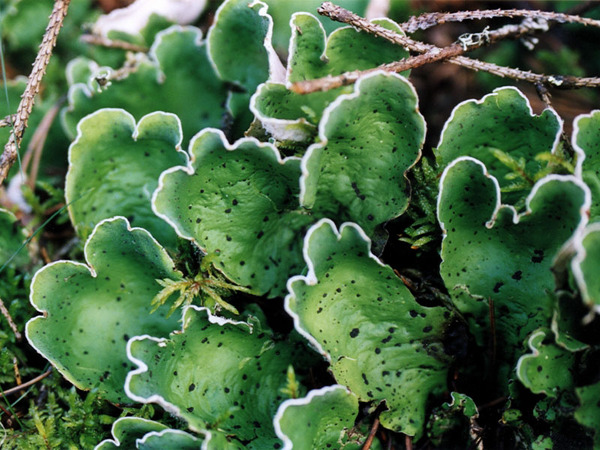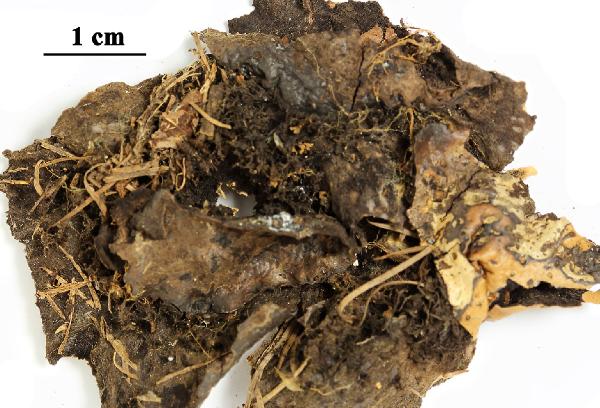Peltigera aphthosa (L.) Willd.
Fl. Berolin. Prodr.: 347, 1787. Basionym: Lichen aphthosus L. - Sp. Pl., 2: 1148, 1753.
Synonyms: Lichen verrucosus Weber; Peltidea aphthosa (L.) Ach.; Peltidea aphthosa var. verrucosa Ach.; Peltigera aphthosa var. microthallina Gyeln.; Peltigera aphthosa var. phymatodes Wallr.
Distribution: N - Frl (Tretiach & Hafellner 2000, Nardini & al. 2013), Ven (Vitikainen 1994, Caniglia & al. 1999, Nascimbene & Caniglia 2003c), TAA (Vitikainen 1994, Caniglia & al. 2002, Nascimbene & al. 2005, 2006, 2008c, 2022, Nascimbene 2008b), Lomb (Anzi Lich. Lang. 458: Vitikainen 1994, Dalle Vedove & al. 2004, Gheza 2019, 2019b, Gheza & al. 2022), Piem (Vitikainen 1994, Isocrono & al. 2003, 2004, Morisi 2005), VA (Rivellini 1994, Vitikainen 1994, Borlandelli & al. 1996, Piervittori & Isocrono 1997, 1999, Piervittori & al. 2001, Valcuvia 2000), Emil (Dalle Vedove & al. 2002, Benesperi & al. 2007, Fariselli & al. 2020), Lig (Brunialti & al. 1999). C - Tosc (Benesperi & al. 2007), Marc, Abr (Nimis & Tretiach 1999).
Description: Thallus foliose, heteromerous and dorsiventral, broad-lobed, loosely attached, forming 15(-24) cm wide rosettes. Lobes elongate, concave, contiguous, 1.5-3(-5) cm broad, up to 12 cm long, usually obtuse to boat-shaped, with ascending, entire to crenate margins. Upper surface erect-tomentose in marginal parts, glabrous in central parts, grey to greenish-grey when dry, bright green when wet, smooth, with up to 2 mm wide, numerous, scattered, dark grey, flattened to wart-like cephalodia containing Nostoc. Lower surface tomentose, whitish in marginal parts, abruptly blackening in central parts, with a few, indistinct, broad veins or veinless, and with a few dark, simple to fasciculate, often confluent, up to 5 mm long rhizines. Upper cortex pseudoparenchymatous; medulla white; lower cortex absent. Apothecia rare, saddle-shaped, terminal, brown, with a continuous, smooth to warted cortex, 7-15 mm. Paraphyses simple, distinctly thickened in upper part. Asci 8-spored, fissitunicate, the thickened apex with a K/I+ blue ring, Peltigera-type. Ascospores 3-7-septate, hyaline to pale brown at maturity, acicular, thin-walled, (47-)53-67(-75) x 4-5 μm. Photobiont chlorococcoid (Coccomyxa), cephalodia with Nostoc. Spot tests: K-, C-, KC-, P-, UV-; or medulla faintly and fleeting C+ and KC+ pink. Chemistry: at least five chemotypes with different combinations of tenuiorin, methyl gyrophorate, gyrophoric acid and triterpenoids.Note: a mainly boreal-montane, circumpolar acidophytic vicariant of P. leucophlebia, found on terricolous mosses and soil rich in humus, mostly in forests but also above treeline; common in the Alps, much rarer in the Apennines. The record from Campania reported by Nimis (1993: 496) is dubious, and probably refers to P. leucophlebia.
Growth form: Foliose, broad lobed
Substrata: soil, terricolous mosses, and plant debris
Photobiont: green algae other than Trentepohlia (primary); cyanobacteria, filamentous (e.g. Nostoc, Scytonema) (secundary, e.g. in cephalodia)
Reproductive strategy: mainly sexual
Commonnes-rarity: (info)
Alpine belt: rather rare
Subalpine belt: common
Oromediterranean belt: very rare
Montane belt: rather common
Submediterranean belt: absent
Padanian area: absent
Humid submediterranean belt: absent
Humid mediterranean belt: absent
Dry mediterranean belt: absent
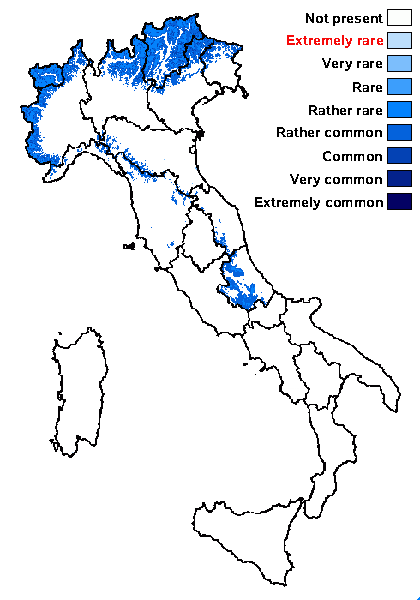
Predictive model
Herbarium samples
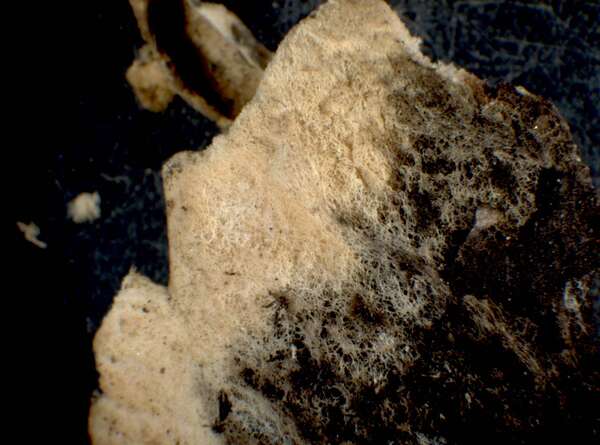

P.L. Nimis; Owner: Department of Life Sciences, University of Trieste
Herbarium: TSB (8707)
2001/12/05
lower surface
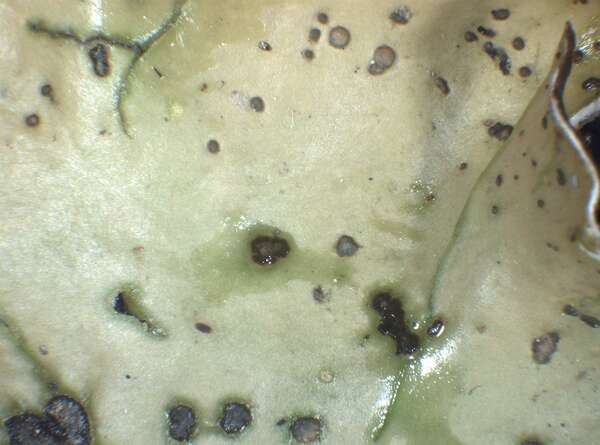

P.L. Nimis; Owner: Department of Life Sciences, University of Trieste
Herbarium: TSB (21158)
2003/03/03
upper surface with cephalodia (wet)
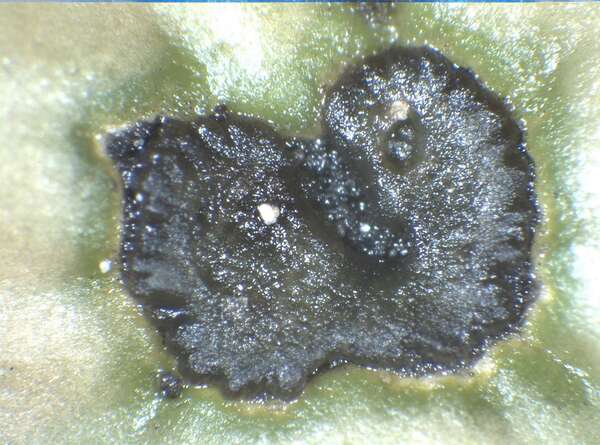

P.L. Nimis; Owner: Department of Life Sciences, University of Trieste
Herbarium: TSB (21158)
2003/03/03
cephalodium (wet)
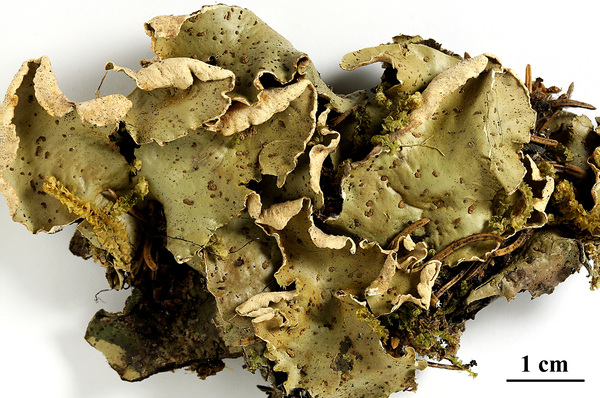

Felix Schumm – CC BY-SA 4.0
[12666], Österreich, Gauertal, Lindauer Hütte, ca. 1900 m, Krummholz. Leg. et det. H. Muhle 09.2005.
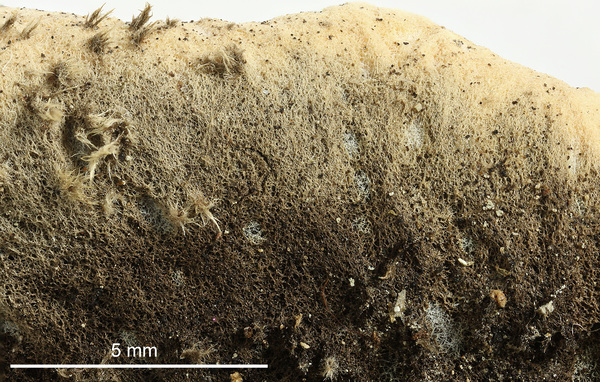

Felix Schumm – CC BY-SA 4.0
[12666], Österreich, Gauertal, Lindauer Hütte, ca. 1900 m, Krummholz. Leg. et det. H. Muhle 09.2005.
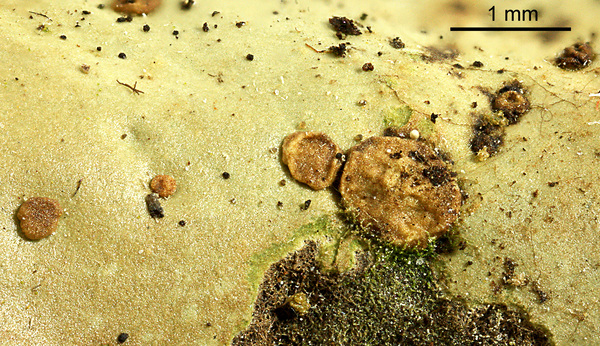

Felix Schumm – CC BY-SA 4.0
[12666], Österreich, Gauertal, Lindauer Hütte, ca. 1900 m, Krummholz. Leg. et det. H. Muhle 09.2005.
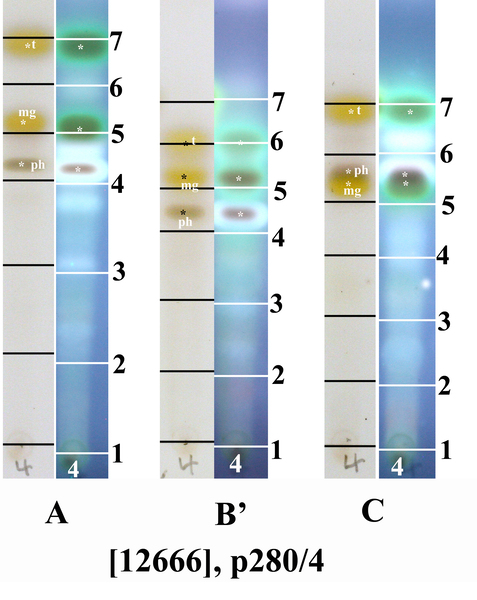

Felix Schumm – CC BY-SA 4.0
[12666], Österreich, Gauertal, Lindauer Hütte, ca. 1900 m, Krummholz. Leg. et det. H. Muhle 09.2005.
HPTLC in den Laufmitteln A, B’ und C nach Säurebehandlung bei Tageslicht und 366 nm UV-Langwelle. 1: Start, 4: Position von Norstictinsäure, 7: Position von Atranorin, t: Tenuiorin, mg: Methylgyrophorat, ph: phlebic acid B.


Juri Nascimbene - CC BY-SA 4.0
Stelvio National Park, Reg. Trentino-Alto Adige Prov. Trento, Italy.
07.2005
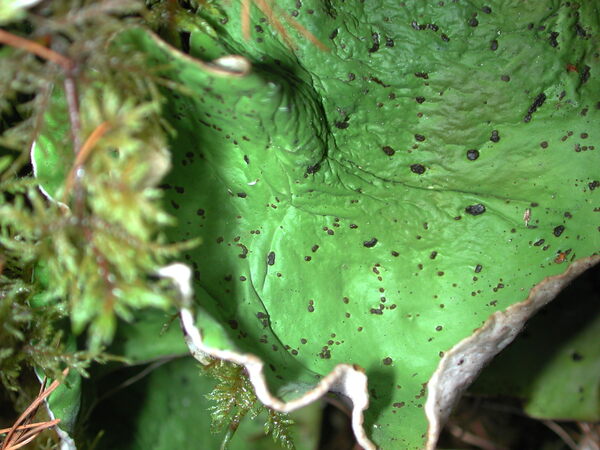

Juri Nascimbene - CC BY-SA 4.0
Stelvio National Park, Reg. Trentino-Alto Adige Prov. Trento, Italy.
07.2005
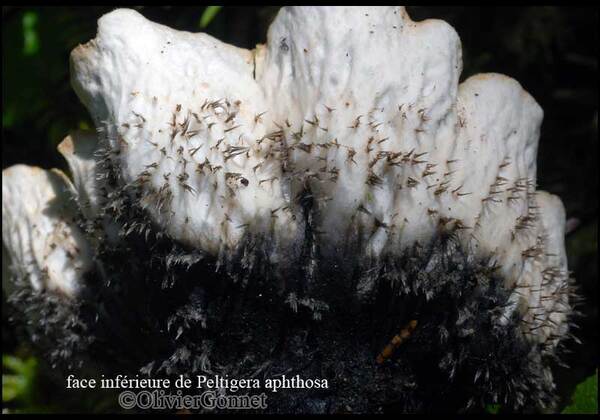
Courtesy Danièle et Olivier Gonnet - Source: https://www.afl-lichenologie.fr/Photos_AFL/Photos_AFL_P/Text_P_2/Peltigera_aphtosa.htm
France, 4/8/2010 - Champagny-le-Haut - Haute-Savoie


Felix Schumm - CC BY-SA 4.0
[1259], Österreich, Land Salzburg, Tennengebirge (bei Bischofshofen),
Anton-Proksch-Haus bei Werfenweng, Ladenberghöhe, ca. 1630 m.
Leg. et det. F. Schumm 24.08.1967. Chemistry (p411/2): tenuiorin,
methyl gyrophorate, hopane-15 ,22-diol.
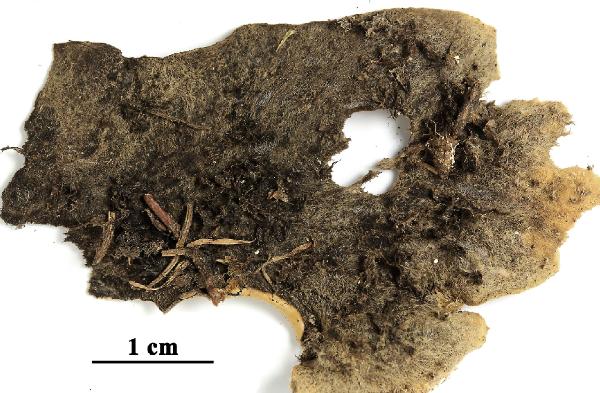

Felix Schumm - CC BY-SA 4.0
[1259], Österreich, Land Salzburg, Tennengebirge (bei Bischofshofen),
Anton-Proksch-Haus bei Werfenweng, Ladenberghöhe, ca. 1630 m.
Leg. et det. F. Schumm 24.08.1967. Chemistry (p411/2): tenuiorin,
methyl gyrophorate, hopane-15 ,22-diol.


Felix Schumm - CC BY-SA 4.0
[4934], Schweiz, Wallis, Champex westl. Orsières, Val de Arpette,
Granituntergrund, ca. 1700 m, SVBL-Exkursion, 22.08.1996. Leg. et
det. F. Schumm, 08.1998. Chemistry (p411/4): tenuiorin, methyl gyrophorate,
hopane-15 ,22-diol.
Growth form: Foliose, broad lobed
Substrata: soil, terricolous mosses, and plant debris
Photobiont: green algae other than Trentepohlia (primary); cyanobacteria, filamentous (e.g. Nostoc, Scytonema) (secundary, e.g. in cephalodia)
Reproductive strategy: mainly sexual
Commonnes-rarity: (info)
Alpine belt: rather rare
Subalpine belt: common
Oromediterranean belt: very rare
Montane belt: rather common
Submediterranean belt: absent
Padanian area: absent
Humid submediterranean belt: absent
Humid mediterranean belt: absent
Dry mediterranean belt: absent

Predictive model
| Herbarium samples |


P.L. Nimis; Owner: Department of Life Sciences, University of Trieste
Herbarium: TSB (8707)
2001/12/05
lower surface


P.L. Nimis; Owner: Department of Life Sciences, University of Trieste
Herbarium: TSB (21158)
2003/03/03
upper surface with cephalodia (wet)


P.L. Nimis; Owner: Department of Life Sciences, University of Trieste
Herbarium: TSB (21158)
2003/03/03
cephalodium (wet)


Felix Schumm – CC BY-SA 4.0
[12666], Österreich, Gauertal, Lindauer Hütte, ca. 1900 m, Krummholz. Leg. et det. H. Muhle 09.2005.


Felix Schumm – CC BY-SA 4.0
[12666], Österreich, Gauertal, Lindauer Hütte, ca. 1900 m, Krummholz. Leg. et det. H. Muhle 09.2005.


Felix Schumm – CC BY-SA 4.0
[12666], Österreich, Gauertal, Lindauer Hütte, ca. 1900 m, Krummholz. Leg. et det. H. Muhle 09.2005.


Felix Schumm – CC BY-SA 4.0
[12666], Österreich, Gauertal, Lindauer Hütte, ca. 1900 m, Krummholz. Leg. et det. H. Muhle 09.2005.
HPTLC in den Laufmitteln A, B’ und C nach Säurebehandlung bei Tageslicht und 366 nm UV-Langwelle. 1: Start, 4: Position von Norstictinsäure, 7: Position von Atranorin, t: Tenuiorin, mg: Methylgyrophorat, ph: phlebic acid B.


Juri Nascimbene - CC BY-SA 4.0
Stelvio National Park, Reg. Trentino-Alto Adige Prov. Trento, Italy.
07.2005


Juri Nascimbene - CC BY-SA 4.0
Stelvio National Park, Reg. Trentino-Alto Adige Prov. Trento, Italy.
07.2005

Courtesy Danièle et Olivier Gonnet - Source: https://www.afl-lichenologie.fr/Photos_AFL/Photos_AFL_P/Text_P_2/Peltigera_aphtosa.htm
France, 4/8/2010 - Champagny-le-Haut - Haute-Savoie


Felix Schumm - CC BY-SA 4.0
[1259], Österreich, Land Salzburg, Tennengebirge (bei Bischofshofen), Anton-Proksch-Haus bei Werfenweng, Ladenberghöhe, ca. 1630 m. Leg. et det. F. Schumm 24.08.1967. Chemistry (p411/2): tenuiorin, methyl gyrophorate, hopane-15 ,22-diol.


Felix Schumm - CC BY-SA 4.0
[1259], Österreich, Land Salzburg, Tennengebirge (bei Bischofshofen), Anton-Proksch-Haus bei Werfenweng, Ladenberghöhe, ca. 1630 m. Leg. et det. F. Schumm 24.08.1967. Chemistry (p411/2): tenuiorin, methyl gyrophorate, hopane-15 ,22-diol.


 INDEX FUNGORUM
INDEX FUNGORUM
 GBIF
GBIF
 DOLICHENS
DOLICHENS
